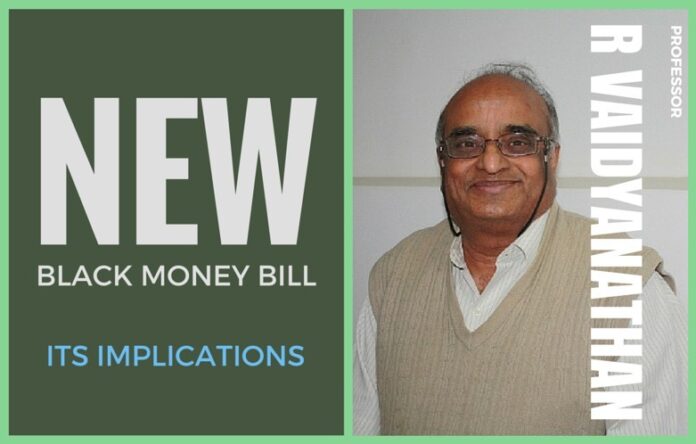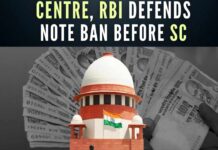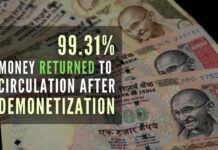
Prof. R Vaidyanathan
Professor of Finance – IIM Bangalore
Summary:
- The new Black Money bill was signed into law by the President of India on May 26, 2015
- Bill is similar to the one passed by the then Government of 1990, except for clever wording
- An example of how fair market value is calculated
Indian Government is taking steps to recover the black money stashed abroad by the residents of India, the act [The Black Money (undisclosed foreign income and assets) and imposition of tax act, 2015] passed by parliament received the consent of the President on 26th May 2015. As per the act “levies tax on undisclosed assets held abroad by a person who is a resident in India at the rate of 30% of the value of such assets, provides for a penalty equal to 90% of the value of such asset, and also provides for rigorous imprisonment of three to ten years for wilful attempt to evade tax in relation to a undisclosed foreign income or asset”.
The above mentioned punishment can be avoided by making use of the “Compliance Window”, which is open from July 1st 2015 till 30th September 2015. It’s an open invitation to disclose all the assets overseas, jewellery, immovable property, archaeological collections and paintings, shares and securities and shares in unlisted firms abroad. Central Board of Direct Taxes (CBDT) will calculate at fair market value for the same.
During the 1990s (1997 to be specific) then Government had given Supreme Court a commitment about not introducing “voluntary disclosure schemes”. Hence the term is “compliance window” even though there are no differences!
The process:
- The Act and compliance window is effective July 1st
- Tax and penalties will be calculated from assessment year 2016-17 (FY16)
- Post compliance window, stern terms will be in place.
- 120% tax and penalties; jail term of up to 10 years on the cards
The compliance window duration is 3 months which is of short period, but enough time for the people who wish to disclose income and assets stashed abroad and take an opportunity to convert the Black Money to White Money.
“The person making a declaration under the provisions, would be liable to pay tax at the rate of 30% of the value of such undisclosed asset. In addition, he would also be liable to pay penalty at the rate of 100% of such tax (i.e., a further 30% of the value of the asset as on the date of commencement of the Act). Therefore, the declarant would be liable to pay a total of 60% of the value of the undisclosed asset declared by him. This special rate of tax and penalty specified in the compliance provisions will override any rate or rates specified under the provisions of the Income-tax Act or the annual Finance Acts.”
Explanatory circular on compliance under Chapter 6 of the provisions of the Income Tax Act
Rules notified provide clarity on calculation of undeclared assets
The Act also states, after the person or entity declares incomes or assets and pays the dues, “shall not be prosecuted under the Act and the declaration made by him will not be used as evidence against him under the Wealth Tax Act, the Foreign Exchange Management Act, the Companies Act or the Customs Act. Wealth tax shall not be payable on any asset so disclosed”.
For valuing shares and securities of listed entities, the rules said the fair market value will be the higher of the cost of acquisition or average of the lowest and highest price on the date of valuation.
Although it is going to be the tough task for CBDT to arrive at fair market value, they have laid down the formula:
- Value of bullion, jewelry or precious stone shall be the higher of, it’s cost of acquisition; and the price that bullion, jewelry would ordinarily fetch if sold in open market.
- Valuation of archaeological collections, drawings, paintings, sculptures or any work of art (hereinafter referred to as artistic work) shall be the higher of, its cost of acquisition; and the price that the artistic work shall ordinarily fetch if sold in the open market on the valuation.
- The fair market value of quoted share and securities shall be the higher of, its cost of acquisition; and the price as determined the average of the lowest and highest price of such shares and securities quoted on any established securities market on the valuation date;
- The fair market value of an immovable property shall be higher of,- its cost of acquisition; and the price that the property shall ordinarily fetch if sold in the open market on the valuation date
- Value of an account with a bank shall be,- the sum of all the deposits made in the account with the bank since the date of opening of the account; or where a declaration of such account has been made under
- The CBDT also provided a formula for calculating the fair market value of an unquoted equity shares and provided a methodology for calculating the interest of a person in a partnership firm, association of persons or Limited Liability Partnership (LLP).
Example:
A house property (H1) located outside India was bought in 1997 for twenty lakh rupees. It was sold in 2001 for twenty five lakh rupees which were deposited in a foreign bank account (BA). In 2002 another house property (H2) was bought for thirty lakh rupees. The investment in H2 was made through withdrawal from BA. H2 has not been transferred before the valuation date and its value on the valuation date is fifty lakh rupees. Assuming that the value of BA as computed under Rule 3(1)(e) is seventy lakh rupees, the Fair Market Value (FMV) of the assets shall be as below:
FMV of H1: (Higher of Rs.20 lakhs ($32000) and 25 lakhs ($39,500)) – Rs.25 lakhs (invested in BA) = Nil
FMV of BA: Rs.70 lakhs ($111,000) – Rs.30 lakhs ($47,000) (invested in H2) = Rs.40 lakhs ($63,000)
FMV of H2: (Higher of Rs.30 lakhs and 50 lakhs) = Rs. 50 lakhs ($79,000)The fair market value of an asset determined in a currency which is one of the permitted currencies designated by the Reserve Bank of India under the Foreign Exchange Management Regulations, shall be converted in to Indian currency as per the reference rate of the Reserve Bank of India on the date of valuation.
Where the fair market value of an asset is determined in a currency other than one of the permitted currencies designated by the Reserve Bank of India then, such value shall be converted into United States Dollar on the date of valuation as per the rate specified by the Central Bank of the country or jurisdiction in which the asset is located and such value in United States Dollar shall be converted into Indian currency as per the reference rate of the Reserve Bank of India on the date of valuation
Questioning a provision of the notification, tax expert R N Lakhotia says, “It will be very difficult to determine the fair market value in first place and secondly if the value of say a property purchased at `100 lakhs 10 years ago and now values at `40 lakhs, what will the government do in that case.”
Lakhotia mentioned that before the Lehman Bros crisis, property prices were in its peak during 2007-08, and till today property prices in the US haven’t recovered ground. They are still down by 35-40%.
The government has no estimate of the possible inflows under the compliance scheme, but tax experts ET spoke to say that they have received queries about the new law.
The government has maintained that the motive of the law is not to generate revenue through a onetime compliance window but to deter future tax violation. There is no universally accepted estimate of the quantum of black money stashed away by Indian citizens.
We close with the note that people may come forward to pay their taxes and penalties and government will fetch good amount of revenue by imposing this act.
The possibilities of the Act being successful is high, as the similar scheme [Voluntary Disclosure of Income Scheme (VDIS)] laid down in the year 1997 had over 350,000 people had disclosed their income and assets under this scheme, which bought revenue of INR 78 billion to Indian finance ministry. The scheme were closed on 31 December 1997.
VDIS succeeded more than the India finance ministry expected. Over 350,000 individuals, with a sprinkling of companies and firms, disclosed their undisclosed incomes. Sequestered assets worth was over Rs.260 billion ($4.1 billion). With tax levied at 30% of the disclosed asset, the inflow of around Rs.78 billion ($1.23 billion) to the treasury is a good one-fifth of what the Government had collected in direct taxes in the past financial year. Watching the success, then Union Finance Minister, P. Chidambaram commented, “It is my faith that, given a chance, the people of India come clean”. He claimed that his team of Income Tax officials had got Rs.330 billion ($5.21 billion) to turn white.
The author is professor of finance at IIM Bangalore – Views are personal.
Note:
- The conversion rate used in this article is 1 USD = 63.325 rupees
- Text in bold usually indicates a link to another article, which when clicked will open in a new window.
- नकली खबर लक्षण है, बीमारी नहीं! - April 16, 2018
- Fake News/ Accreditation and Sedition - April 4, 2018
- Two Poisonous Seeds - March 15, 2018











[…] https://performancegurus.net/black-money-bill-and-compliance-window/ […]